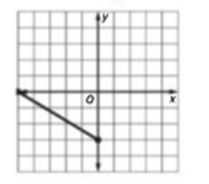
Concept explainers
a.
To write: The equation for the line containing the segment shown.
a.
Answer to Problem 54PFA
The equation is
Explanation of Solution
Given:
The line segment in the graph represents one side of a square.

Calculation:
From the graph it is seen that the line segment is passing through the points (0,-3) and (-5,0).
So the equation of the line passing through these two points can be found out using two-point form, which is given as,
So, plugging in the values as
Conclusion:
Therefore equation 2 is the equation of the line containing the segment.
b.
To identify: What must be true about the sides adjacent and opposite the segment to form a square?
b.
Answer to Problem 54PFA
The slope of the side opposite to the segment should be
And the slopes of the sides adjacent to the segment should be
Explanation of Solution
Given:
Equation of the line segment is
Calculation:
The segment adjacent to the given segment must have perpendicular slope.
Now, slope of the given segment is,
Slope of the opposite side of the square will be same as that of the above segment i.e.
Now, the slope of the adjacent sides will be perpendicular to the above segment. So,
Conclusion:
c.
To write: The equations of the lines containing the sides of the square adjacent to the segment.
c.
Answer to Problem 54PFA
1.
2.
Explanation of Solution
Given:
Slopes of the lines containing the sides of the square adjacent to the segment has been found above as
Also these lines pass through the points (0,-3) and (-5,0).
Calculation:
Therefore equation of the line passing through the point (0,-3) and having slope
And equation of the line passing through the point (-5,0) and having slope
Conclusion:
d.
To Find: The equation of the line containing the opposite segment passing through the vertex (3,2).
d.
Answer to Problem 54PFA
The equation is
Explanation of Solution
Given:
The vertex (3,2) lies on the opposite segment.
And the slope of opposite segment we found above as
Calculation:
Therefore, the equation of the line passing through the segment having slope
e.
To find: The 4 vertices of the square.
e.
Answer to Problem 54PFA
The four vertices of the square are (0,-3), (-5,0), (3,2) and (-2,5).
Explanation of Solution
Given:
The three vertices are found above as (0,-3), (-5,0) and (3,2).
Calculation:
The fourth vertex should be the point of intersection of the sides with equations
So solve equations
So, multiplying equation A by 5 and equation B by 3 and then adding them, we get
Plugging
Therefore, the fourth vertex of the square is (-2,5)
Conclusion:
f.
To find: The quadrilateral figure is a square or not.
f.
Answer to Problem 54PFA
The quadrilateral figure is a square.
Explanation of Solution
Given:
The four vertices of the square are given as (0,-3), (-5,0), (3,2) and (-2,5).
Calculation:
Therefore, one diagonal of the square will pass through the vertices (0,-3) and (-2,5).
And the other diagonal will pass through the vertices (-5,0) and (3,2).
Find slope of the diagonal passing through the points (0,-3) and (-2,5) by using,
Find slope of the diagonal passing through the points (-5,0) and (3,2) by using,
Two lines are perpendicular, then the product of their slopes is -1.
And from above,
Conclusion:
Now, since the two diagonals of the quadrilateral are perpendicular, also its adjacent sides are perpendicular to each other, the quadrilateral is a square.
Chapter 4 Solutions
Algebra 1, Homework Practice Workbook (MERRILL ALGEBRA 1)
Additional Math Textbook Solutions
College Algebra with Modeling & Visualization (5th Edition)
Basic Business Statistics, Student Value Edition
Elementary Statistics (13th Edition)
Calculus: Early Transcendentals (2nd Edition)
Using and Understanding Mathematics: A Quantitative Reasoning Approach (6th Edition)
- Safari File Edit View History Bookmarks Window Help Ο Ω OV O mA 0 mW ర Fri Apr 4 1 222 tv A F9 F10 DII 4 F6 F7 F8 7 29 8 00 W E R T Y U S D பட 9 O G H J K E F11 + 11 F12 O P } [arrow_forwardSo confused. Step by step instructions pleasearrow_forwardIn simplest terms, Sketch the graph of the parabola. Then, determine its equation. opens downward, vertex is (- 4, 7), passes through point (0, - 39)arrow_forward
- In simplest way, For each quadratic relation, find the zeros and the maximum or minimum. a) y = x 2 + 16 x + 39 b) y = 5 x2 - 50 x - 120arrow_forwardIn simplest terms and step by step Write each quadratic relation in standard form, then fi nd the zeros. y = - 4( x + 6)2 + 36arrow_forwardIn simplest terms and step by step For each quadratic relation, find the zeros and the maximum or minimum. 1) y = - 2 x2 - 28 x + 64 2) y = 6 x2 + 36 x - 42arrow_forward
- Write each relation in standard form a)y = 5(x + 10)2 + 7 b)y = 9(x - 8)2 - 4arrow_forwardIn simplest form and step by step Write the quadratic relation in standard form, then fi nd the zeros. y = 3(x - 1)2 - 147arrow_forwardStep by step instructions The path of a soccer ball can be modelled by the relation h = - 0.1 d 2 + 0.5 d + 0.6, where h is the ball’s height and d is the horizontal distance from the kicker. a) Find the zeros of the relation.arrow_forward
 Algebra and Trigonometry (6th Edition)AlgebraISBN:9780134463216Author:Robert F. BlitzerPublisher:PEARSON
Algebra and Trigonometry (6th Edition)AlgebraISBN:9780134463216Author:Robert F. BlitzerPublisher:PEARSON Contemporary Abstract AlgebraAlgebraISBN:9781305657960Author:Joseph GallianPublisher:Cengage Learning
Contemporary Abstract AlgebraAlgebraISBN:9781305657960Author:Joseph GallianPublisher:Cengage Learning Linear Algebra: A Modern IntroductionAlgebraISBN:9781285463247Author:David PoolePublisher:Cengage Learning
Linear Algebra: A Modern IntroductionAlgebraISBN:9781285463247Author:David PoolePublisher:Cengage Learning Algebra And Trigonometry (11th Edition)AlgebraISBN:9780135163078Author:Michael SullivanPublisher:PEARSON
Algebra And Trigonometry (11th Edition)AlgebraISBN:9780135163078Author:Michael SullivanPublisher:PEARSON Introduction to Linear Algebra, Fifth EditionAlgebraISBN:9780980232776Author:Gilbert StrangPublisher:Wellesley-Cambridge Press
Introduction to Linear Algebra, Fifth EditionAlgebraISBN:9780980232776Author:Gilbert StrangPublisher:Wellesley-Cambridge Press College Algebra (Collegiate Math)AlgebraISBN:9780077836344Author:Julie Miller, Donna GerkenPublisher:McGraw-Hill Education
College Algebra (Collegiate Math)AlgebraISBN:9780077836344Author:Julie Miller, Donna GerkenPublisher:McGraw-Hill Education





